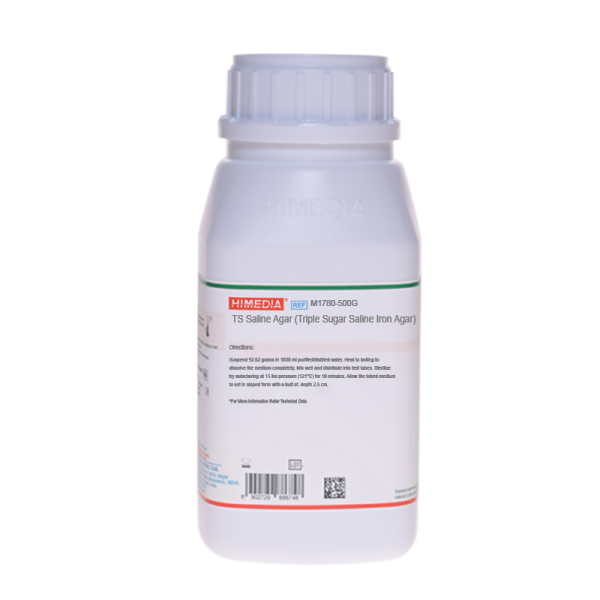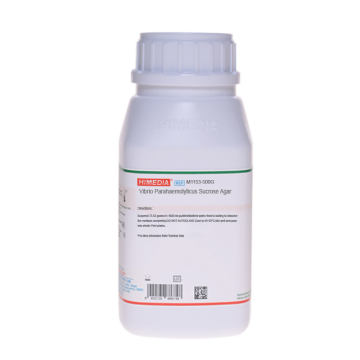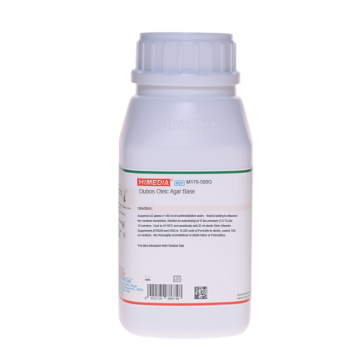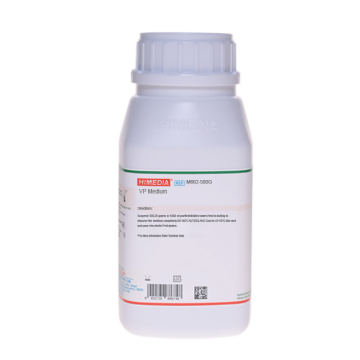 Your enquiry has been submitted
Your enquiry has been submitted
TS Saline Agar (Triple Sugar Saline Iron Agar)
This medium is used for the identification of Vibrio species especially Vibrio parahaemolyticus on the basis of dextrose, lactose and sucrose fermentation and hydrogen sulphide production.
Composition**
| Ingredients | Gms / Litre |
|---|---|
| Peptic digest of animal tissue | 20.000 |
| Meat extract | 3.000 |
| Yeast Extract | 3.000 |
| Sodium chloride | 30.000 |
| Lactose | 10.000 |
| Sucrose | 10.000 |
| Glucose | 1.000 |
| Ferric citrate | 0.300 |
| Phenol red | 0.024 |
| Sodium thiosulfate | 0.300 |
| Agar | 15.000 |
Final pH ( at 25°C): 7.4±0.2
**Formula adjusted, standardized to suit performance parameters
Directions
Suspend 92.62 grams in 1000 ml distilled water. Heat to boiling to dissolve the medium completely. Mix well and distribute into test tubes. Sterilize by autoclaving at 15 lbs pressure (121°C) for 10 minutes. Allow the medium to set in a sloping position to give a butt of depth about 2.5cm.
Principle And Interpretation
TS Saline Agar (Triple Sugar Saline Iron Agar) is in accordance with ISO 8914:1990 (1) recommended for identification of Vibrio parahaemolyticus.
Peptic digest of animal tissue, meat extract and yeast extract provide nitrogenous compounds, sulphur, trace elements and vitamin B complex etc. Sodium chloride maintains osmotic equilibrium. Lactose, sucrose and glucose are the fermentable carbohydrates. Sodium thiosulphate and ferric ions make H2S indicator system. Phenol red is the pH indicator.
Organisms that ferment glucose produce a variety of acids, turning the colour of the medium from red to yellow. More amount of acids are liberated in butt (fermentation) than in the slant (respiration). Growing bacteria also form alkaline products from the oxidative decarboxylation of peptone and these alkaline products neutralize the large amounts of acid present in the butt. Thus the appearance of an alkaline (red) slant and an acid (yellow) butt after incubation indicates that the organism is a glucose fermenter but is unable to ferment lactose and/or sucrose. Bacteria that ferment lactose or sucrose (or both), in addition to glucose, produce large amounts of acid enables no reversion of pH in that region and thus bacteria exhibit an acid slant and acid butt. Gas production (CO2) is detected by the presence of cracks or bubbles in the medium, when the accumulated gas escapes. Thiosulphate is reduced to hydrogen sulphide by several species of bacteria and H2S combines with ferric ions of ferric salts to produce the insoluble black precipitate of ferrous sulphide. Reduction of thiosulphate proceeds only in an acid environment and blackening usually occurs in the butt of the tube.
Alkaline slant / acid butt - only glucose fermented
Acid slant / acid butt - glucose and sucrose fermented or glucose and lactose fermented or all the three sugars, glucose, lactose and sucrose fermented.
Bubbles or cracks present - gas production
Black precipitate present -H2S gas production.
Quality Control
Appearance: Light yellow to pink homogeneous free flowing powder
Gelling: Firm, comparable with 1.5% Agar gel.
Colour and Clarity of prepared medium: Pinkish red coloured clear to slightly opalescent gel forms in tubes as slants.
Reaction: Reaction of 9.26% w/v aqueous solution at 25°C. pH : 7.4±0.2
pH: 7.20-7.60
Cultural Response: M1780: Cultural characteristics observed after an incubation at 35-37°C for 18-24 hours.
| Organism | Inoculum (CFU) | Growth | Slant | Butt | Gas | H2S |
|---|---|---|---|---|---|---|
| Citrobacter freundii ATCC 8090 | 50-100 | luxuriant | acidic reaction, yellowing of the medium | acidic reaction, yellowing of the medium | positive reaction | positive, blackening of medium |
| Enterobacter aerogenes ATCC 13048 | 50-100 | luxuriant | acidic reaction, yellowing of the medium | acidic reaction, yellowing of the medium | positive reaction | negative, no blackening of medium |
| Escherichia coli ATCC 25922 | 50-100 | luxuriant | acidic reaction, yellowing of the medium | acidic reaction, yellowing of the medium | positive reaction | negative, no blackening of medium |
| Klebsiella pneumoniae ATCC 13883 | 50-100 | luxuriant | acidic reaction, yellowing of the medium | acidic reaction, yellowing of the medium | positive reaction | negative, no blackening of medium |
| Proteus vulgaris ATCC 13315 | 50-100 | luxuriant | alkaline reaction, red colour of the medium | acidic reaction, yellowing of the medium | negative reaction | positive, blackening of medium |
| Salmonella Paratyphi A ATCC 9150 | 50-100 | luxuriant | alkaline reaction, red colour of the medium | acidic reaction, yellowing of the medium | positive reaction | negative, no blackening of medium |
| Salmonella Typhi ATCC 6539 | 50-100 | luxuriant | alkaline reaction, red colour of the medium | acidic reaction, yellowing of the medium | negative reaction | positive, blackening of medium |
| Salmonella Typhimurium ATCC 14028 | 50-100 | luxuriant | alkaline reaction, red colour of the medium | acidic reaction, yellowing of the medium | positive reaction | positive, blackening of medium |
| Shigella flexneri ATCC 12022 | 50-100 | luxuriant | alkaline reaction, red colour of the medium | acidic reaction, yellowing of the medium | negative reaction | negative, no blackening of medium |
| Escherichia coli ATCC 8739 | 50-100 | luxuriant | acidic reaction, yellowing of the medium | acidic reaction, yellowing of the medium | positive reaction | negative, no blackening of medium |
| Escherichia coli NCTC 9002 | 50-100 | luxuriant | acidic reaction, yellowing of the medium | acidic reaction, yellowing of the medium | positive reaction | negative, no blackening of medium |
| Klebsiella pneumoniae ATCC 10031 | 50-100 | luxuriant | acidic reaction, yellowing of the medium | acidic reaction, yellowing of the medium | positive reaction | negative, no blackening of medium |
| Vibrio parahaemolyticus ATCC 17802 | 50-100 | luxuriant | alkaline reaction, red colour of the medium | acidic reaction, yellowing of the medium | negative reaction | negative, no blackening of medium |
Storage and Shelf Life
Store below 30°C in tightly closed container and the prepared medium at 2 - 8°C. Use before expiry date on the label.
Reference
- International Organization for Standardization (ISO) , 8914:1990.
| Product Name | TS Saline Agar (Triple Sugar Saline Iron Agar) |
|---|---|
| SKU | M1780 |
| Product Type | Regular |
| Physical Form | Powder |
| Origin | Animal |
| Packaging type | HDPE |
| References | 1. International Organization for Standardization (ISO) , 8914:1990. |
| Customized Product Available | No |










